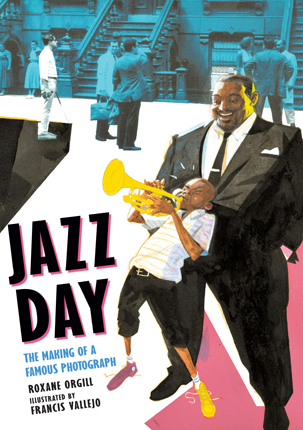| Jazz day : the making of a famous photograph Author: Orgill, Roxane | ||
| Price: $6.50 | ||
Summary:
What happens when you invite as many jazz musicians as you can to pose for a photo in 1950s Harlem? Playful verse and glorious artwork capture an iconic moment for American jazz.
| Illustrator: | Vallejo, Francis |
| Accelerated Reader Information: Interest Level: MG Reading Level: 6.10 Points: 1.0 Quiz: 180666 | Reading Counts Information: Interest Level: 3-5 Reading Level: 5.70 Points: 3.0 Quiz: 68422 | |
Reviews:
School Library Journal (00/02/16)
Full Text Reviews:
School Library Journal - 02/01/2016 Gr 4 Up—A collection of poetry that focuses on the day graphic designer Art Kane orchestrated the iconic 1958 photograph of American jazz greats on a stoop in Harlem. Though many may recognize the photograph, fewer will know the story of its creation. While working on a special issue of Esquire magazine dedicated to jazz, Kane decided to see how many musicians he could gather in one place. The book starts on the morning the photograph was taken, with Kane standing in the street he's closed for the occasion, nervously hoping his call for appearances will be heeded. The verse spotlights the cast of characters that slowly materializes, with some short biographic poems and even one about Count Basie's hat. The offerings lead up to a foldout spread of the photograph itself, cued by a black page with the word click in white print. The remaining selections address the issue's immediate reception and laud Kane's accomplishment. The text is accompanied by vibrant, spectacular acrylic and pastel paintings by debut illustrator Vallejo. The volume includes an introduction, a lengthy author's note (with a useful key to the photograph), and short biographies of the major players. VERDICT A rich, unique, playful, and masterfully orchestrated work; Kane himself would undoubtedly be proud.—Jill Heritage Maza, Montclair Kimberley Academy, Montclair, NJ - Copyright 2016 Publishers Weekly, Library Journal and/or School Library Journal used with permission.
Booklist - 03/15/2016 *Starred Review* In 1958, Esquire was preparing an issue on American jazz, and graphic designer Art Kane pitched the idea of getting as many jazz greats together as possible for a black-and-white photograph. So far, not much here to grab a young audience, right? But sometimes books, like music, are more than the sum of their hooks. Orgill, who has written about jazz for adults (and Ella Fitzgerald for children) is here paired with artist Vallejo, a welcome newcomer to the world of picture books, and they offer a memorable ode to a time and place, a celebration of music that was both hot and cool, and an endearing snapshot of the men and women who wrote, played, and sang jazz. Kane’s photograph, Harlem, 1958, is here immortalized in Orgill’s poetry, which swings and sways, and Vallejo’s vibrant artwork, which captures not just the players but the mood on 126th Street where the photo shoot took place. That there were kids there on that day, leaning out of windows and grabbing Count Basie’s hat, adds a child-friendly dimension. For those who want more, there’s an enlightening author’s note, short but sturdy biographies of those featured in the poems, a list of related books and films, and a key to the photo with all 57 musicians named. - Copyright 2016 Booklist.
Bulletin for the Center... - 04/01/2016 It seemed worth a try—casting a broad invitation to New York’s jazz community to show up in front of a designated Harlem brownstone for an Esquire magazine photo shoot on a hot August day of 1958. Reporter Art Kane, armed with a borrowed camera, struck gold: a great turnout and a great shot that claimed its place in American iconography. Orgill relives the day through twenty-one poems that highlight the gamble, the quirkiness, and the musicians. In the opener, “Early,” Kane stands alone in the street and worries (“A crazy request/ what if nobody shows”). They do show up, but posing them is like herding cats: “no one listens/ musicians/ don’t hear/ words of instruction/ only music.” Orgill imagines a pair of siblings among the twelve neighborhood boys who made their way into the photo, with the starstruck older brother wrangling his little brother, who just doesn’t get the momentousness of what’s happening. With all in place, the camera clicks: “click/ click/ it has to be perfect/ for Esquire/ Dizzy sticks out his tongue.” Months later, the street boy buys himself a copy: “Me, Alfred/ With a patch on my knees/ But jeez/ I’m in a magazine.” Kids indifferent to jazz or photography will be swept up nonetheless in the novelty of the episode, the idiosyncrasies of the participants, and the shoulder-rubbing between the neighborhood kids and the adult celebs. Vallejo’s mixed-media illustrations are gems of freewheeling portraiture, drawing from the iconic photo itself and other film taken throughout the day. Orgill supplies biographical info on Art Kane and the musicians highlighted in her poems, and best of all, a double-page photo reproduction folds out at just the right moment from an asphalt black page with a single “‹ click.” Perfect. EB - Copyright 2016 The Board of Trustees of the University of Illinois.
School Library Journal - 12/01/2016 Gr 4 Up—Readers eavesdrop on the behind-the-scenes making of Art Kane's now-iconic photo, Harlem 1958, which featured many of the era's jazz greats. The warm, eye-popping acrylic and pastel illustrations are in harmony with the direct, evocative prose/poetry, which provides multiple perspectives, from the boys watching on the curb to pianist William "Count" Basie, pianist/composer Mary Lou Williams, and the well-dressed saxophonist Lester "Pres" Young. A wonderful snapshot of one specific place and time. - Copyright 2016 Publishers Weekly, Library Journal and/or School Library Journal used with permission.



